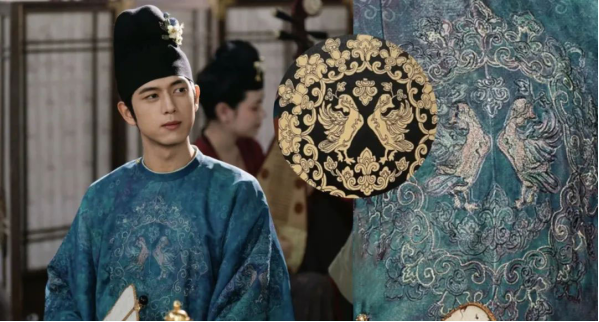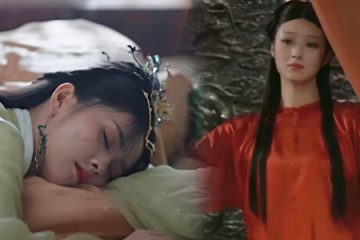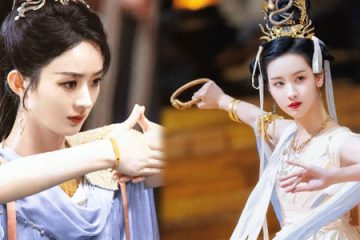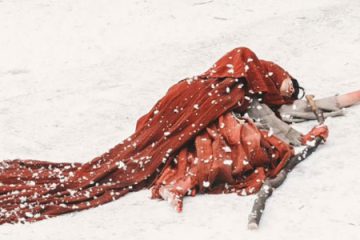Jiang Changyang’s Wardrobe in Flourished Peony

In Flourished Peony, Jiang Changyang, played by Li Xian, changes his outfit almost every time he appears. He’s truly got a “Tang – Dynasty – style men’s wardrobe.” Even Li Xian himself said the costumes in this drama were the most flamboyant ones he’s ever worn.
I. The Mastermind Behind the Wardrobe
When it comes to Jiang Changyang’s male hanfu in Flourished Peony , round medallion patterns and pearl – string designs stand out. These are unique artistic treasures of the Tang Dynasty. After absorbing the essence of foreign cultures, the Tang people developed these patterns. As early as the Northern Dynasties, the pearl – string round medallion patterns, characteristic of Central and Western Asia (Persia), made their way to the Central Plains via the Silk Road. By the Tang Dynasty, these patterns were imbued with strong Chinese characteristics.

Here, let’s first explain a term called “Lingyanggong Pattern (陵阳公样 in Chinese).” This is a unique type of decoration found on Sichuan brocade and Tang Dynasty bricks, and it can be said to account for half of the patterns on Tang Dynasty brocade. Its “designer” was Dou Shilun (窦师纶), a renowned silk – weaving expert in the Tang Dynasty, who designed more than a dozen patterns throughout his life. According to Zhang Yanyuan’s Famous Paintings through the Ages “Dou Shilun served as the Grand Executive Secretary of Yizhou and also supervised the construction work. He created auspicious brocade and imperial silk fabrics, which were exquisitely patterned and colorful. The people of Sichuan called these patterns ‘Lingyanggong Pattern’.”

Most of the patterns designed by Dou Shilun took phoenixes, sheep, horses, deer, unicorns, etc. as their themes and formed symmetrical patterns. They incorporated and absorbed the characteristics of foreign cultures’ decorative patterns, such as those of Persia and Sogdia. For example, the round medallion was the main body, or it was surrounded by pearl – string patterns, and inside were various patterns of animals and plants. Auspicious birds, rare beasts, precious – appearance flowers, and birds were interspersed and combined to form a complex and symmetrical pattern. As a result, he was conferred the title of “Duke of Lingyang.” In memory of him, the patterns he designed, as well as similar patterns that emerged in the Tang Dynasty, were all called “Lingyanggong Pattern” by later generations.

Most of the patterns we will talk about below are derived from the “Lingyanggong Pattern.” Now, let’s take another look at Li Xian’s wardrobe. Most of the hanfu feature these patterns: Precious Flower Round Medallion Pattern, Winged Horse Pearl – String Pattern, and Opposing Birds Round Medallion Pattern. Let’s break them down. The precious flowers, winged horses, and opposing birds are the central patterns, while the round medallions and pearl – string patterns are the main elements of the outer patterns.

II. What Are the Patterns of the Tang Dynasty?
The round medallion pattern is one of the most classic patterns of the Tang Dynasty, and it can also appear together with the pearl – string pattern. The word “窠 (round medallion)” originally referred to the habitats of insects, birds, and beasts, and it was extended to mean the concentration of patterns. This design concept skillfully combines various elements such as flowers, birds, beasts, utensils, and figures to create circular or nearly circular patterns that resemble natural nests.

The round medallion patterns in the Tang Dynasty are rich and colorful, and many of them carry the auspicious connotations of “completeness and harmony.” To be more accurate, the round medallion pattern is not a single type of design.
It is mainly categorized into four major types: The Pearl-String Round Medallion Pattern, where a series of round beads encircle the central motif, creating a magnificent and orderly aesthetic; the Floral and Botanical Round Medallion Pattern, which takes lush flowers and plants as its theme, showcasing the vibrant vitality of nature; the Precious Appearance Flower Round Medallion Pattern, which integrates the essence of Eastern and Western aesthetics and features idealized floral forms; and finally, the Animal Round Medallion Pattern, which incorporates lively and vivid animal images into hanfu patterns, adding an element of fun and vitality to them.
Each of these round medallion patterns has its own unique characteristics, and together they form a glorious chapter in the art of Tang Dynasty textiles.
So, let’s have a guess. What are the patterns from left to right?

Here’s the answer: From left to right, the patterns are the Precious Appearance Flower pattern, the Animal pattern, the Pearl-String Round Flower pattern, and the Floral and Botanical pattern.
1. Pearl-String Pattern
The Pearl-String pattern, also known as the “Sasanian-style Pearl-String pattern,” is deeply influenced by Sasanian Persian art and symbolizes the divine light. During the Sui and Tang dynasties, the Pearl-String pattern was composed of a series of evenly-sized round beads arranged in a band or a ring. These beads formed circular or diamond-shaped frames around the main motif, giving it a highly decorative appearance. For example, in the Dunhuang murals, there are patterns where the Pearl-String pattern is used as an edge decoration for winged horses, winged beasts with bird heads and animal bodies, and other motifs.

2. Winged Horse Pattern
The image of the winged horse is a pattern that combines the elements of the Western Regions and the Great Tang Dynasty. This kind of horse is also known as the “Heavenly Horse” and is regarded as an auspicious beast that brings good fortune. In the design of the pattern, the horse remains the main focus. The wings are short and closely attached to the horse’s body, showcasing either a single or symmetrical beauty. It is often paired with auspicious patterns such as the pearl-string pattern, bodhi trees, and auspicious clouds.

3. Precious Flower Pattern
The Precious Flower Pattern is the most common pattern in the Tang Dynasty and is also known as the “Precious Appearance Flower Pattern.” The Precious Appearance Flower Pattern follows the design principle of “central symmetry.” The visual focus is concentrated in the center of the pattern, and from there, it spreads out layer by layer. It’s just like petals following each other in shape, either converging towards the center or blooming outwards, presenting a symmetrical and radiating beautiful form.
The overall composition is based on a cross or a “米” (Chinese character resembling a rice paddy grid) pattern layout and is ingeniously divided into an even number of parts, such as four, six, eight, or twelve. This layout not only has a rhythmic sense but also contains the profound meaning of perfection and the contemplation of the universe.
We’ve mentioned the Precious Appearance Flower pattern in a previous blog post and provided a detailed introduction. If you’re interested, you can check it out:
The Blossoming Composite Floral Pattern: A Cultural Code in Hanfu Design

4. Opposing Birds Pattern
The Opposing Birds Pattern is inherited from the flower and bird patterns of previous dynasties. The pattern of birds holding flowers in the Tang Dynasty is influenced by the pattern of birds with ribbons in the Sasanian Persia. It is mainly divided into two types: the round medallion opposing birds style and the style where birds stand on flower platforms.
The patterns of the Tang Dynasty also skillfully combine the characteristics of these two types. The opposing birds inside the round medallion are in elegant postures, and there are flower platforms at their feet for decoration. The layers of scrolling grass and flowers in the outer circle highlight the magnificent beauty of the patterns on Tang Dynasty textiles.

Summary

After learning all these, don’t you think that the hanfu patterns of the Tang Dynasty are actually really flamboyant and fashionable? It’s clearly visible that they are rich and luxurious. So, going back to the point, now that we’ve grasped the secrets of designing Tang Dynasty patterns: they should be symmetrical, carry auspicious meanings, and have unique colors. Do you think we can design our own Tang Dynasty patterns?



0 Comments